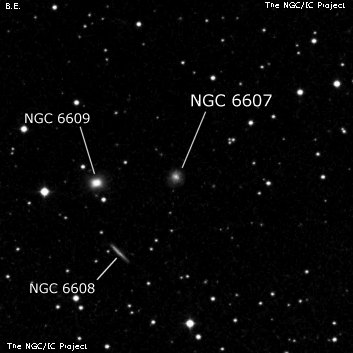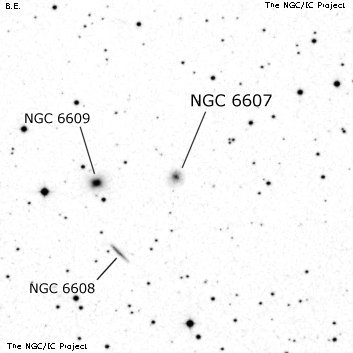NGC/IC Project Restoration Effort
(This is a very very beta version)
NGC6607


Basic Information
Location and Magnitude
Right Ascension: 18:12:14.9
Declination: +61:20:0
Constellation: DRA
Visual Magnitude: 15.3
Historic Information
Discoverer: Swift L.
Year of discovery: 1883
Discovery aperture: 16.0
Observational
Summary description: eF, pS, R, v diffic
Sub-type: Sb
Corwin's Notes
=====
NGC 6607, 6608, and 6609. This is a trio of objects all credited to Lewis
Swift. They were all discovered on the night of 4 Aug 1883, and are listed in
Swift's first paper as being the 5th, 6th, and 7th of 8, respectively (numbers
91-93 in his sequential numbering of the entire list). The other five objects
are N6592, N6594, N6597, N6601, and N6617. Though Swift's positions aren't
too good for these five, either, the galaxies are nevertheless unambiously
identified by Swift's comments about nearby stars (or the lack of them).
N6601, by the way, is the only other object of the eight that Swift found that
night in 1883; the remaining four are dated 14 June 1885.
Swift's declination for NGC 6608 is the problem. He places it at exactly the
same declination as NGC 6609 just 15 arcsec north of NGC 6607. So, while
there are three galaxies in the area, only two are at Swift's declination
while the other is 2 arcmin south. Furthermore, the southern object is a
faint edgewise Scd or Sd with a low mean surface brightness. Not only does it
not match Swift's descriptions of shape ("R", "R", and "lE" for the three
objects) it is so faint (around V = 15.5 at a guess -- it is not included in
CGCG -- compared to V = 14.5 and 15.0 for the other two) that I would be
surprised if Swift could have seen it at all. The object that Swift described
as the faintest of the batch of eight (NGC 6617, which see) is considerably
brighter than than this spindle. In addition to that, Swift says there is a
"vF star near" his object -- there are none near the spindle that he could
have seen that are not nearer NGC 6609 (and that leads to yet another
hypothesis for NGC 6608; see the last paragraph of this note).
Still, there are three galaxies here, and three NGC numbers. If we assume
that Swift's RA's for the four objects found this night are correct among
themselves in a relative sense, then we can apply the correction necessary to
make his RA for NGC 6601 agree with the GSC position (+13 seconds of time) to
the others. This leads to RA's for the others that are different from the
true RA's by -4, -4, and -3 seconds of time, respectively. Thus, Swift's RA's
for the three galaxies are in very good relative agreement.
So, in spite of my doubts that he saw the faint edgewise galaxy (MCG
+10-26-024), I'm going to assume a 2 arcmin error in the declination for this
object and call it NGC 6608. The other two, NGC 6607 and NGC 6609, fit his
descriptions very well -- including the "F star near" NGC 6609 -- so there
is no problem with them.
As a final possibility, I'm going to suggest that perhaps, just perhaps,
Swift's observations of the latter two objects (numbers 92 and 93 in his list)
refer to the same galaxy. Had the observations been made on different nights,
I would have said "A-ha!" at the beginning of this story and equated them
with hardly a doubt left. As is, we'd have to assume some sort of blunder in
Swift's observations within a single night in a small area of sky. With that
third galaxy just south, though -- well, Occam's razor slashes deeply enough
that it remains the more likely choice (but I've put colons on, just in case).
Steve's Notes
=====
NGC 6607
24" (7/19/12): faint, small, round, 24", low even surface brightness. In a trio with brighter NGC 6608 2.3' E and extremely difficult NGC 6609 (identification uncertain) 2.7' SE. Fifth of 7 or 8 faint NGC galaxies discovered by Swift in a 30' group.
17.5" (7/21/98): this very difficult object required averted to glimpse a 15" spot just 2.2' W of brighter NGC 6608.
17.5" (6/11/88): extremely faint and small, round. Forms a pair with slightly brighter NGC 6608 2.2' E. This galaxy is misidentified as NGC 6608 in the CGCG.



